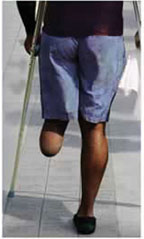
 Amputation more likely for Blacks
Amputation more likely for Blacks
By Kimberly Leonard
Black Americans on Medicare are three times more likely than other patients to lose a leg to amputation because of complications with diabetes and peripheral arterial disease, according to a new study.
Regional disparities are also apparent in the report, released Tuesday by the Dartmouth Atlas Project. It found that amputation rates for Black patients with diabetes and peripheral arterial disease in the rural Southeast can be as high as seven times the rate of other regions. There also was an eight-fold difference across regions for Black patients who were likely to have surgery to in-crease blood circulation to their legs, a measure that can help prevent amputation down the road.
The report examined Medicare claims from 2007 to 2011 and divided the country into 306 regional markets defined by hospital use. The Medicare data classified patients as either Black or nonblack.
Mississippi showed some of the widest disparities by race. There were 14.2 amputations per 1,000 beneficiaries for Black patients in Meridian and 16.1 in Tupelo, compared to 3.8 and 4.7, respectively, for nonblack patients.
The national average rate of leg amputation from 2007 to 2011 was 2.4 per 1,000 Medicare beneficiaries with diabetes and peripheral arterial disease. The amputation rate among Black patients was 5.6 per 1,000, or almost three times higher than the rate among other beneficiaries.
In almost all cases, when comparing Black and nonblack patients, the lowest-risk Black patients had a higher risk of amputation than nearly all non Black patients.
Type 2 diabetes is a condition in which the body doesn’t use insulin properly and causes blood sugar levels to rise. It can result from lifestyle factors, such as poor diet and low physical activity. Type 1 diabetes is a condition in which the body doesn’t produce insulin. It affects 5 percent of patients with diabetes and is usually diagnosed in children. Both types can result in amputation if the disease isn’t properly managed. Nearly 100,000 leg amputations are performed annually in Medicare patients, and more than half of them occur in patients with diabetes.
Diabetes can lead to peripheral arterial disease, a circulatory problem in which narrowed arteries reduce blood flow to limbs, causing pain or numbness. If there is an ulcer or a sore on a patient’s foot, it can result in a life-threatening infection because blood cannot circulate to the leg properly. Amputation is a treatment of last resort.
The report also showed that Black Americans on Medicare are less likely to seek routine preventive care. Preventive measures include foot exams and controlling cholesterol and blood sugar levels. Sometimes surgical methods, such as by-pass surgery, are used, because patients can improve when blood flow to their feet is restored.
The use of preventive measures varied by region and race. Of Black diabetic patients on Medicare, 75.2 percent received a blood lipids test for cholesterol levels in 2010 compared to 81.5 percent of nonblack patients, the report showed.
The rate of surgical treatments also varied, from fewer than 4.8 procedures per 1,000 patients in Columbus, Georgia, to 33.5 in Petoskey, Michigan. Rates among Black patients varied from 4.8 procedures per 1,000 in Columbus, Georgia, to 41.7 in Amarillo, Tex., and Hattiesburg, Miss.
“We can’t really tell why some patients might not be engaged in pursuing care that might limit amputation, such as routine foot checks,” Dr. Philip Goodney, director of the Center for the Evaluation of Surgical Care at Dartmouth-Hitchcock Medical Center and co-author of the report, said in a call with reporters. “Sometimes the resources are there but for what-ever reason patients don’t find their way to the right treatments.”
The report showed patients have an opportunity to become more involved in decision-making about their care and can prevent amputation. Tests for blood sugar control and cholesterol levels are inexpensive and universally available, the report said.
“This is a striking example of something that is entirely preventable,” Dr. Marshall Chin, a University of Chicago professor, said Tuesday. To reduce disparities, he said, health care providers need to address social and economic issues, such as barriers that prevent patients from eating healthy and the affordability of prescription medication patients receive.
“This report leaves little doubt where the focus of amputation prevention needs to be directed,” Goodney said in a statement.
“While a comprehensive approach is necessary, focusing on Black patients in poor, rural regions of the U.S. is likely to be the best place to start,” he said. “We must look for opportunities to expand education and preventative care for all patients at risk for amputation. However, initiating broader efforts in these high-risk communities will be essential to have the greatest impact.”


Be the first to comment